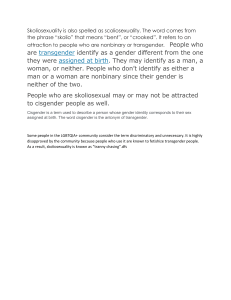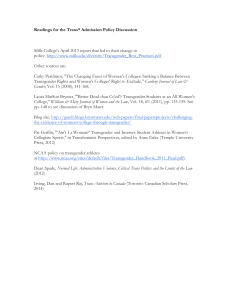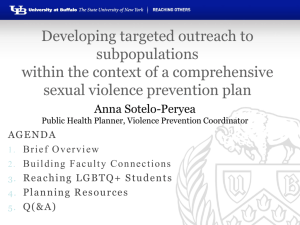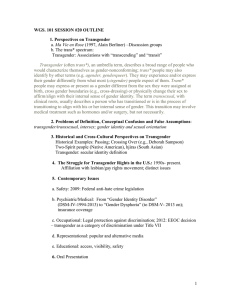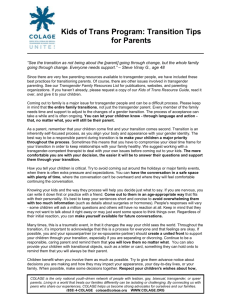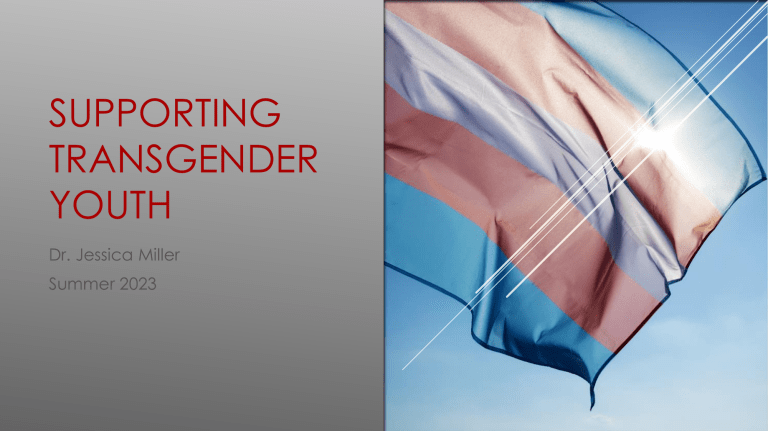
SUPPORTING TRANSGENDER YOUTH Dr. Jessica Miller Summer 2023 You will find an index card at your seat. Use one side of the card for each question One thing you know about transgender people One question you have about transgender people WARM UP You are here because you have a transgender or nonconforming child in your school or classroom You are open to learning You care deeply for all of your students You want to learn more because you will eventually have a transgender or non-conforming student You are an administrator who has a transgender or nonconforming student and you are unsure of what you can and cannot do You are coming with a mindset of inquiry and growth ASSUMPTIONS Recognize and define the various pronouns available for students identify themselves. Recognize the belief that gender does not exist on a binary. Identify the importance of providing transgender students support on campus. To heighten awareness of definitional and other issues related to transgender gender identity as they pertain to school Construct a knowledge base about the various experiences and challenges faced by transgender students at school, as well as how to address these matters To provide an opportunity for participants to apply their newfound awareness and knowledge. LEARNING INTENTIONS Introduce Yourselves! Think about the gender messages you received growing up What is one message you received about gender while growing up from your parents/family? What is one message you received about gender while growing up, from peers? What is one message you received about gender from the media as you were growing up? Choose one person from your group to share out IN YOUR TABLE GROUPS Some tough numbers 2020 CDC National Youth Risk Behavior Surveillance Results 16% of LGBTQ kids have been threatened or injured with weapon at school 29% of LGBTQ kids have been bullied at school 22% of LGBTQ kids have attempted suicide 29% of trans kids have been threatened or injured with a weapon at school 43% of trans kids have been bullied at school 29% of trans kids have attempted suicide 7% of cisgender students threatened at school IN COMPARISON 7% cisgender students attempted suicide 35% of LGBTQ kids were disciplined more for public affection 24% of LGBTQ kids and 47% of trans kids weren’t allowed to use chosen name or pronoun 12% of LGBTQ kids were discouraged to participate in school activities MORE HARD NUMBERS Prevalence 2.5 – 4 times higher substance use •Higher risks for earlier onset and recent use Hazardous alcohol use 2 – 2 ½ times more likely to use cocaine/meth in lifetime 2 x times likely to report recent 30 day prescription pain medication use More than 3 times likely to use cigarettes or vapes in school SUBSTANCE ABUSE STATISTICS Gilbert et al., 2018; Day, et al., 2017; DePedro et al, 2017 LGBTQ kids identified... Non-LGBTQ kids identified... 26% non-accepting families 25% Classes/exams/grades 21% School/bullying problems 14% College/career 18% Fear of being outed 11% Financial pressures related to college AMONG THOSE ASKED TO DESCRIBE THE MOST IMPORTANT PROBLEM FACING THEIR LIVES RIGHT NOW... Lower Self-Esteem Depression, Substance Abuse, Self-Harm Loss of family/friends Homelessness Lower Performance Increased absenteeism Lower academic achievement Fewer Opportunities Educational/Extracurricular THE EFFECT OF PRESSURE Less likely to pursue post- secondary education “It is not justice if we leave behind members of our community, if we ignore the interconnected oppression of those we share community with.” - Skylar Lee Loving Artistic Passionate Died by suicide at age 16 School Realities Knowing little about transgender people Being unsure of state laws LGBTQ YOUTH WHO HAVE AT LEAST ONE ACCEPTING ADULT ARE 40% LESS LIKELY TO ATTEMPT SUICIDE 1 Provide a safe space TEACHERS… 2 Change lives---that’s their job 3 Save lives---that’s their power A REAL LIFE EXAMPLE Biological Sex •Male •Female •Intersex Sexual Orientation •Heterosexual •Homosexual •Bisexual •Asexual Human Gender Expression •Masculine •Feminine •Androgynous •Queen Gender Identity •Transgender •Cisgender •Nonbinary •Pangender •Agender PRONOUNS AND PREFERRED NAMES Students have the right to be addressed by a name and pronoun corresponding to the gender identity consistently asserted at school. Creating an environment of supportive students & staff BEST PRACTICES • Develop a Policy • Ask the tough questions • Encourage teachers to be good allies • Develop an inclusive classroom culture • Establish community allies • Know the law is on your side Policies reflect priorities Diversity, equity, inclusion (DEI) Educate staff on policies Discuss and review clear expectations DEVELOP A POLICY • Bullying • Harassment • Microaggressions • Dress codes • Sex education • School-wide messaging • Safe spaces ASK THE TOUGH QUESTIONS AND GENUINELY LISTEN Interrupt Question Educate Echo ENCOURAGE STAFF TO BE ALLIES Develop an inclusive classroom culture Model pronoun usage Facilitate conversations about identity Challenge gender norms Find opportunities for inclusion in lesson plans Continue to learn about inclusivity Correct misinformation Know the landscape of hate Support those who are targeted Establish parental relationships with those who may need to be calmed ESTABLISH COMMUNITY ALLIES Fosters an atmosphere of respect Demonstrates understanding and care Results in a friendlier environment Creates a safer and more inclusive environment When an individual’s identity is accepted, then their sense of self is increased WHY USE APPROPRIATE TERMINOLOGY It’s a phase People blaming me that I’m just indulging my child in a childhood whim Child changes their mind after transition has begun Self-Harm Name change Eating Disorders Saying “goodbye” to the child I knew and the memories we had together Confusion - Child still does things that are gender conforming, such as paints nails. Not accepted by other family members Not accepted by peers Insurance won’t pay for hormone treatment or gender reassignment surgery Not accepted by society Sometimes it’s hard for the parent to accept their child will be different from other children Bathroom safety Wearing non gender conforming clothes in public I’m not good at advocating and I want to avoid confrontation Conflict with religious beliefs What is typical child/tween/teen behavior? Is binding the chest safe What will happen on school trips/camp? FAMILY CONCERNS AND FEARS Assess self-harm Trevor Project - More than 1.8 million LGBTQ youth (ages 13-24) contemplate a suicide attempt each year in the US Identify child’s stressors (stigma, discrimination, bullying, or a perception of bias) Know what is happening within the child’s school - 31% of Trans children are harassed or bullied by teachers or staff Identify if the child has disclosed identity to others Try and understand-seek out education for yourself Seek out a mentor/role models for the child Affirm leadership of LGBTQIA+ youth Don’t assume, ask questions Know terminology Avoid bias opinions Don’t assume child is gay or lesbian Don’t assume that a trans child wants to be the total opposite of the biological sex they were born Suggest ally groups in school and the community Try creating new support groups or programs Do not give up if child does not confide in you or uses any resources you referred Continue to work to keep the child connected to the community (even if it is social media) because strong connection to community is important to resilience WORKING WITH LGBTQIA+ YOUTH The Dos Do be open to listening Do be aware of your implicit biases Do your research to learn more about the history of the struggle in which you are participating Do the inner work to figure out a way to acknowledge how you participate in oppressive systems Do the outer work and figure out how to change the oppressive systems Do use your privilege to amplify (digitally and in person) historically suppressed voices Do learn how to listen and accept criticism with grace, even if it’s uncomfortable The Don’ts Do not expect to be taught or shown. Take it upon yourself to use the tools around you to learn and answer your questions Do not participate for the gold medal in the “Oppression Olympics” (you don’t need to compare how your struggle is “just as bad as” a marginalized person’s) Do not behave as though you know best Do not take credit for the labor of those who are marginalized and did the work before you stepped into the picture Do not assume that every member of an underinvested community feels oppressed Do the work every day to learn how to be a better ally YOUR ACTION PLAN TO ALLYSHIP Trans kid's preferred name Teacher’s beliefs Kid's name SCHOOL CLIMATE The School must address all issues that may negatively impact school climate for transgender students. Training for Staff Training for Students as part of character and civility education, assemblies, targeted training as needed Clear guidelines for staff "Time to support" “Don’t turn my name into just a hashtag.” Skylar Lee “Being a transgender high school student is the least interesting thing about me. It doesn’t define me…but it is the load-bearing pillar of who I am.” Winnie Plante Microagressions “That’s so gay” “Why do you have to flaunt it?” “You’re being oversensitive” “Aren’t you making life hard for yourself?” “Do what you want but I don’t have to approve” MICROAGGRESSIONS Most often individual acts of subtle prejudice or hostility. Microaggressions can be intentional or unintentional Micro does not mean that the action is insignificant Microassaults Small Behaviors that are intentional and purposefully hurtful Microinsults Using the wrong name or pronouns purposefully Rude statements that are usually unintentional or unconscious that indicate ignorance or bias Inappropriate questions about genitals or surgical status Redirecting someone to a separate bathroom Making a face that reveals confusion or disgust Microinvalidations Statements of actions that are usually unintentional that ignore, minimize or nullify a person’s identity Only two gender options on forms Telling non gender conforming people they should understand confusion from cisgender population “I am sure they did not mean it that way…” THREE TYPES OF MICROAGGRESSION This activity shows how microaggressions affect transgender youth in our schools. It is designed to show the struggle of transgender students when navigating a world with people who are not knowledgeable about transgender issues This activity is meant to be challenging and you may experience emotional discomfort Please come as you are ACTIVITY! This is a dramatization, but it does represent the types of prejudice out transgender students feel on a regular basis One of the goals of this session is to better understand the experiences of transgender people Reflection Questions available to you in your handouts MICROAGGRESSION ACTIVITY Maladaptive coping patterns (substance use; high risk behaviors) Parental rejection Stigma Discrimination Provider bias Access to care that address specific needs Lack of insurance coverage Homelessness Bullying, harassment, hostile school environment Internalized “transphobia” Trauma Social isolation MENTAL HEALTH CHALLENGES AMERICAN ACADEMY OF PEDIATRICS. 2017. “As pediatricians, we know that transgender children fare much better when they feel supported by their family, school, and the larger community. Shaming children based on their gender identity or expression is harmful to their social-emotional health and may have lifelong consequences. This includes public discourse that delegitimizes the contributions that transgender individuals make to society.” BARRIERS WHILE WE DID CREATE A MORE EQUITABLE PLAYING FIELD, THERE WAS PUSHBACK. THAT IS BECAUSE FOR THOSE WHO ARE ACCUSTOMED TO PRIVILEGE, EQUITY FEELS LIKE OPPRESSION - BENSON. Unsure of how to talk about gender Question the necessity Lack the courage to talk about gender Lack the knowledge to talk about gender SOME COMMON BARRIERS This activity shows how to support transgender youth in our schools. It is designed to allow us to think about barriers transgender youth face and critically think about what we can do to support them as educational professionals in their lives This activity is meant to be challenging and you may experience emotional discomfort Please come as you are ACTIVITY! NUMBER OFF A transgender student comes to you and tells you they are being harassed every time they try to use the bathroom SCENARIO ONE A gender non-conforming student makes an excuse to rd come see you during 3 period every day. They have PE third period. SCENARIO TWO A student has recently revealed to you that their parent has just come out as transgender and has started transitioning medically. They are concerned about other students finding out and harassing them for it. SCENARIO THREE A student aspiring for college asks for your assistance in finding out about whether there are any transgender affirming colleges to which they might apply. SCENARIO FOUR What other barriers to critical conversations have you seen in your personal life, schools, and districts? TALK ABOUT IT IMAGINING TRANSGENDER YOUTH I will be leading you through a guided imaginary exercise. After a minute of reflection, I will ask you to share one word that describes how you would be feeling at the end of the day you just imagined. After another minute of reflection, I will ask you to describe your emotions in one word All references for both the presentation and handouts can be found in the last pages of your playbook REFERENCES KNOW THE LAW IS ON YOUR SIDE. Dr. Jessica Miller Jessica.miller@morongo.k12.ca.us 279-901-1266 @Dr_JessLEA Leahumanity.com CONTACT ME
